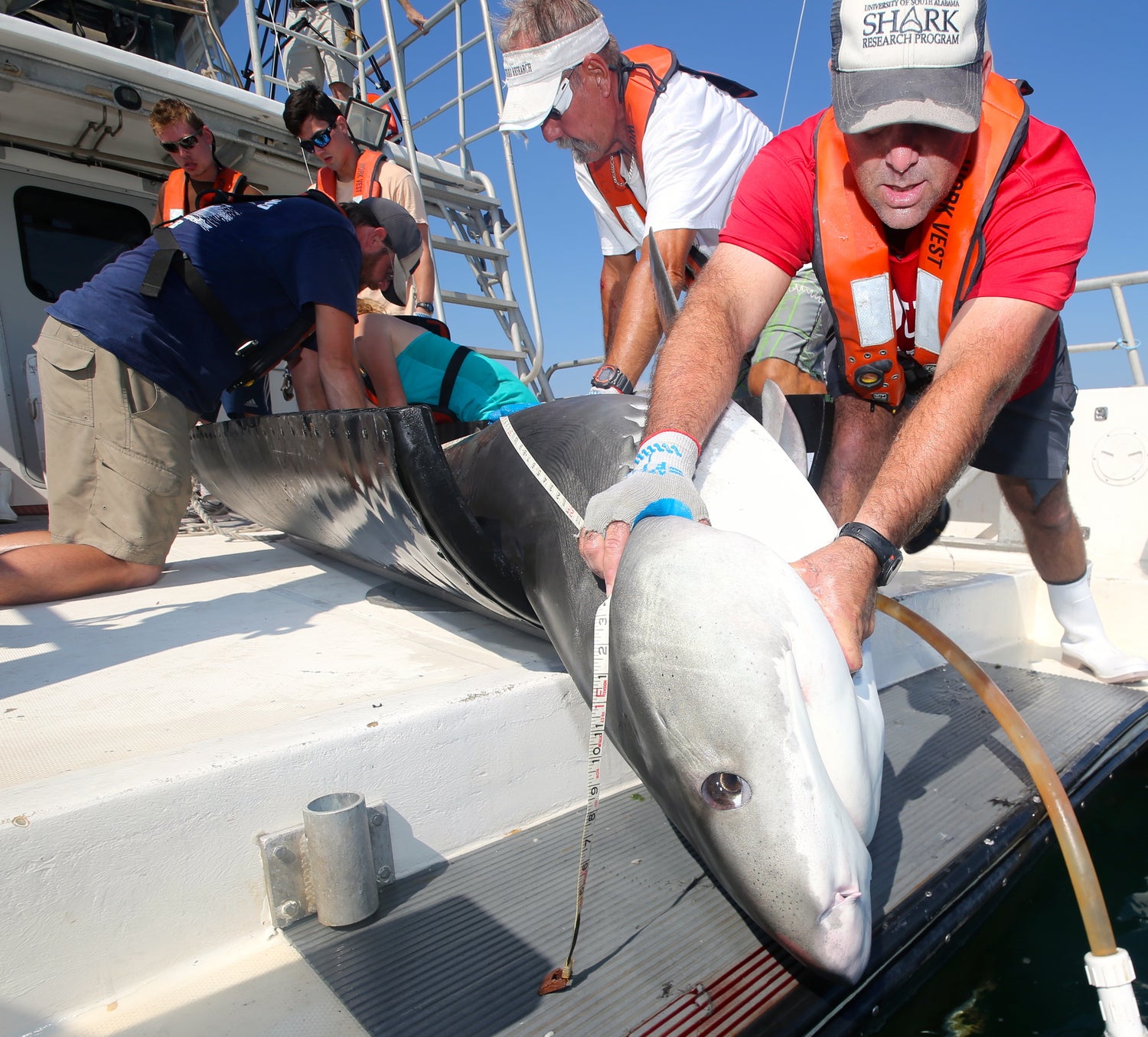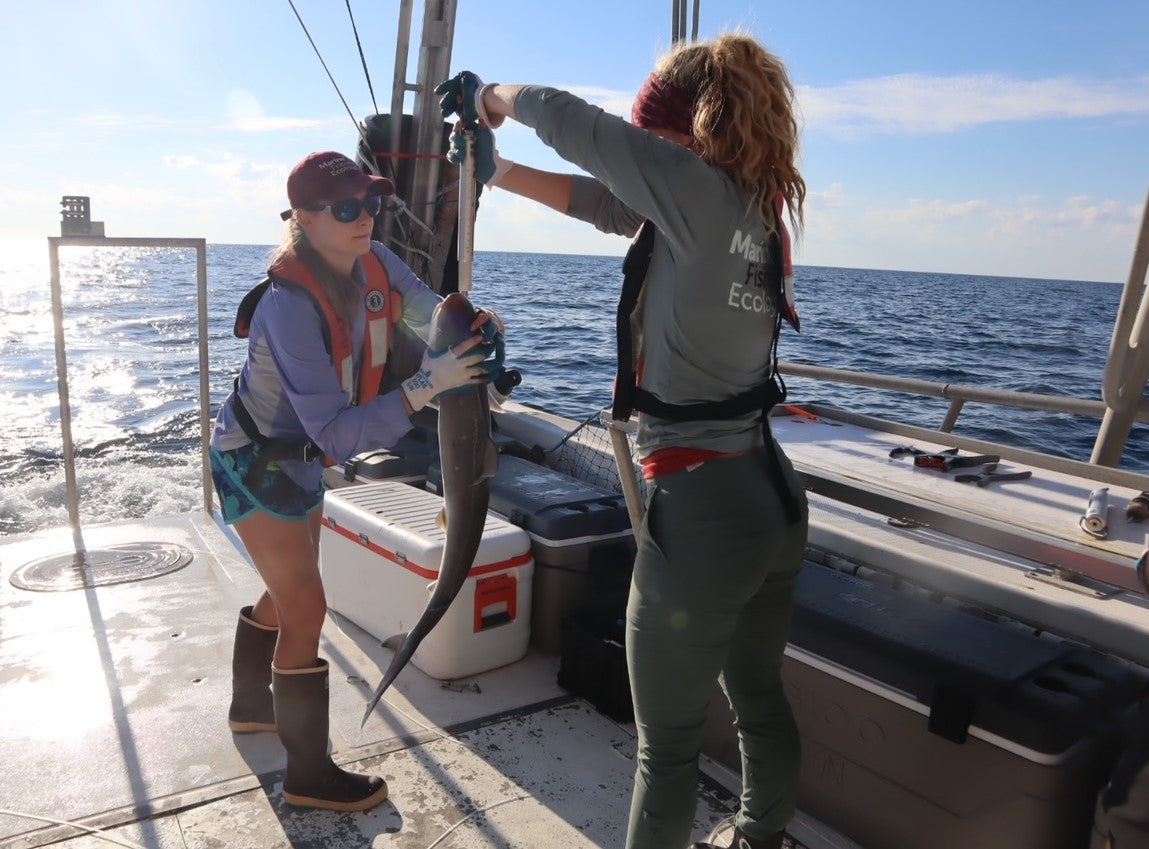Analyzing an Apex Appetite
A Mississippi shark expert takes a starring role on the SharkFest predatory pageant.

Eons ago, when humanity’s ancient antecedents crawled from the sea, some species were on land to stay. Other mammals — majestic whales and agile dolphins — returned to the briny blue from which all life originated on this blue planet. In doing so, they joined leviathans that have mastered the deep and prowl the shores, among them tiger sharks, a species that long has fascinated Marcus Drymon, Ph.D., Associate Extension Professor at Mississippi State University and Marine Fisheries Specialist at the Mississippi-Alabama Sea Grant Consortium.
The coastal waters that attract vacationers during the Summer find the season coincides with spectacularly popular shark documentaries — packed into a week of back-to-back features. Marcus has starred in several such episodes on SharkFest, a National Geographic television special that explores the terrifying and mystifying behavior of predators that play a critical part in keeping a healthy ocean ecosystem.
When the binge-worthy specials air in July, insight into how these hunters operate will again include Marcus’ study of beautifully patterned tiger sharks and a curious phenomenon in which juveniles are found to have an unexpected number of inland birds in their bellies — the same lovely songbirds that cluster around backyard feeders throughout the South.
Hooked on Sharks
Before joining MSU, Marcus was part of the marine sciences faculty at the University of South Alabama and the Dauphin Island Sea Lab, where much of his research began. His obsession with sharks — the way the rhythms of the ocean guide them through a landscape that is both familiar and ever-changing — dates back to childhood
“Like most small kids — 7 or 8 years old — I was fascinated with all things shark,” says Marcus, a Kentucky native. “My dad is an airline pilot so we had the good fortune to travel all over the world because of his job. I had the opportunity to see a lot of really interesting marine places like the Bahamas, other parts of the Caribbean, Mexico, and South America. That’s where I developed a love for the ocean, and, in particular, sharks.”
Like many terrestrial dwellers, Marcus feared sharks—their ominous profile, prominent dorsal fin, and gimlet eye. “I would see them in the water when I was snorkeling or when I was on a boat, and I would just force myself to stay in the water and just check them out,” Marcus says. “The longer I was able to stay in the water with them and observe them in their natural settings, the more curious I became and the more enamored I became. That led to me reading everything I could about them and, ultimately, going to college to study them.”
From analysis at the Bimini Biological Field Station in the Bahamas with lemon sharks in his early research days, Marcus has continued to catch and study all species of sharks, measuring, examining, and tagging them for release. During 20 years of research, television producers often contacted him about his studies, several of which have been highlighted during SharkFest.
“It’s a thrill to see all of the work you’ve been putting in and what you’ve learned being displayed to a broad audience,” Marcus says. “With respect to the tiger shark studies, I think it’s just such an unusual marriage between a large, highly migratory predatory species like a tiger shark and then tiny quaint and unassuming songbirds. That kind of juxtaposition really defined that study and made it really interesting.“
In his examination of young tiger sharks, Marcus saw — when flushing (lavaging) their stomachs, a striking number of songbirds had been consumed. The question then becomes, “Why?”
“To see a tiger shark occasionally eat a little songbird is interesting, but it’s not particularly rare,” Marcus says. “I think what was neat about our study was trying to draw these linkages saying, OK, the prevalence of these sharks eating small birds is actually much higher than we would expect due to random encounters. There must be something about the patterns of these migratory birds and/or the hunting strategies with these small tiger sharks that lends itself well to that interaction. We found that these individuals are more prone to eat things they didn’t have to actively hunt.”
With songbirds falling from the skies like apples from trees, they present an easy meal for a young predator learning to hunt. Imagine a hollow-winged creature flying determinedly along its migratory route, hitting a storm over the Gulf of Mexico, and in exhaustion landing on the swells of an inhospitable sea. The result is a cycle-of-life ending to that bird’s pilgrimage.
“We felt like the most satisfying aspect of that project was tying together those two things and establishing those linkages,” Marcus says. “These birds leave the Yucatan Peninsula in Mexico and fly nonstop until they hit the continental U.S. Their first real opportunity to stop is on Dauphin Island, Alabama. Where we’re located is a really unique area in terms of the migratory patterns of songbirds.”

The tiger sharks feeding on birds are neonates — yes, 3-foot-long “baby sharks” — in a species that grows quickly. By age 3 to 5, they can be 10 feet long.
That’s just one of the factors that makes this possibly Marcus’ favorite species to study. The blunt-nose predators are also one of the most voracious and known as “the garbage can of the sea” for their tendency to eat anything they find.
“They have an extraordinarily wide dietary breadth — fish, crustaceans, small marine mammals, terrestrial birds, marine birds, debris, and trash,” he explains. “They’re also highly migratory, which I think is
fascinating.”
Marcus is studying the area about 60 miles off the coast of Louisiana, Mississippi, and Alabama, where the research vessels bring in all manner of sharks—blacktips, hammerheads, sandbars, bulls, spinners, and more.
“Now, we’re seeing shark populations that are relatively stable, if not slightly increasing,” Marcus says. “This is really good news. We know that sharks were over-fished significantly in the ’80s and ’90s. And it wasn’t until the mid ’90s with management measures in place that we started to see their populations start to slowly recover. But because of their life history traits, they grow very slowly. They’re late to mature. Once they’re over fished, their populations take a long time to recover. Fast forward 30 years from the mid 1990s and here we are finally in 2024 seeing populations that are slowly starting to recover.”
Marcus explains that the Gulf of Mexico is one of the world’s best examples of a well—managed, sustainable shark fishery.
“Sharks are a resource to be harvested just like a red snapper or speckled sea trout,” he says. “A lot of people eat shark. Science-based fishery management plans are the foundation of sustainable fisheries for sharks, but this is different than culling sharks.”
Marcus and his team are now focusing their studies on depredation, which occurs when a shark targets a fish an angler has hooked and is battling to get to the boat. It’s a human-wildlife conflict that has steadily escalated in the past 10 years, and Marcus is seeking to determine why these encounters are on the rise.
“We want to understand what we can do to reduce those types of interactions,” he says. “We want to reverse the narrative that’s starting to build, which is, ‘The narrative has changed from ‘sharks threaten our safety’ to ‘sharks threaten our recreational fishing opportunities.’
“We’re working hard to remind people just how cool sharks are, and that they are an important part of a healthy ecosystem.”
Dorsal fins cutting through the surface or deep beneath the azure waves, sharks embody the spirit of the ocean itself – mysterious, majestic, and undeniably captivating.
Look for Marcus on National Geographic’s SharkFest, which
begins June 30 this year.



